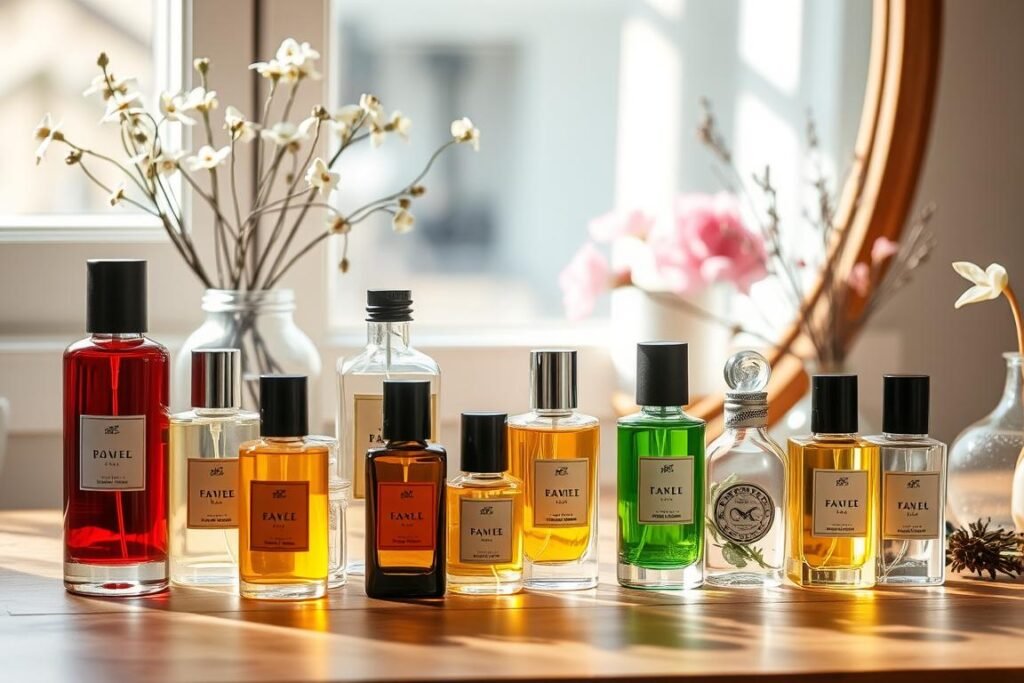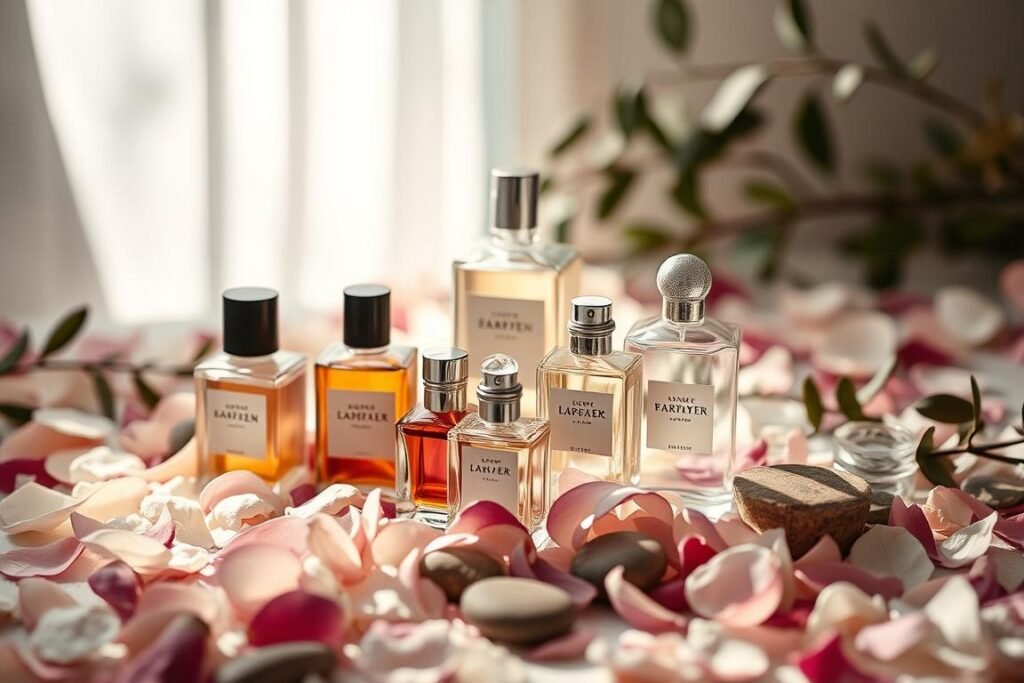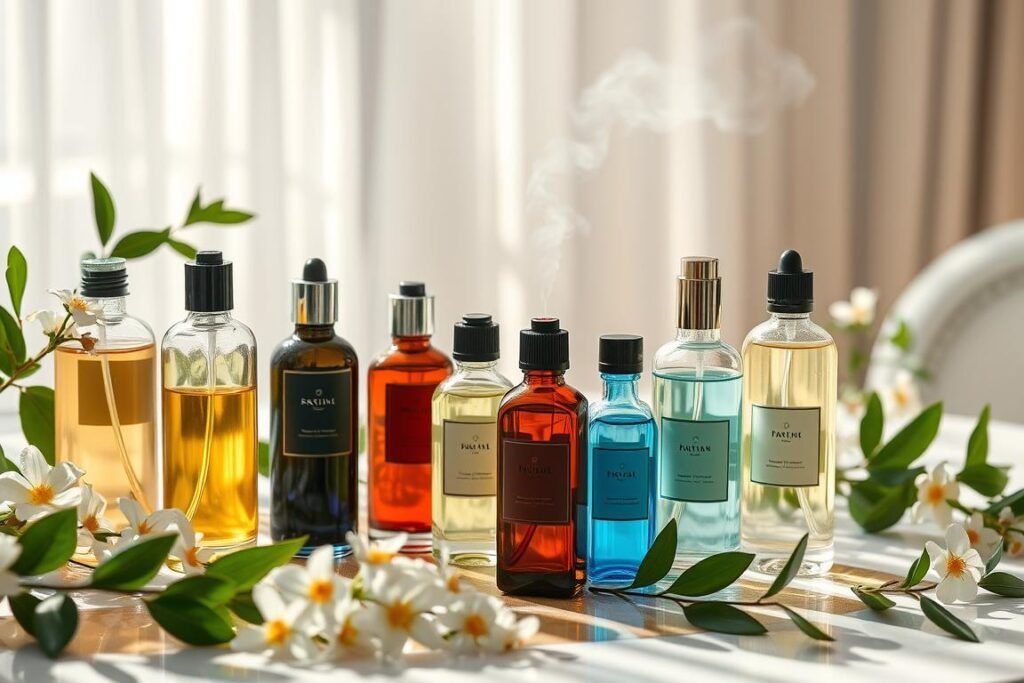Fragrance layering is an art that lets you express yourself and create unique scents. It has ancient roots, from Mesopotamia to religious ceremonies. By mixing different fragrances, you can craft a scent that’s all your own.
This trend has become popular on TikTok. Influencers and experts share their favorite fragrance layering mixes.
Key Takeaways
- Fragrance layering allows you to create personalized scents by combining multiple fragrances.
- Layering can increase the longevity and intensity of a fragrance throughout the day.
- Proper application techniques and choosing complementary scents are crucial for successful layering.
- Experimenting with fragrance combinations can lead to unique, signature scents.
- Layering fragrances has been a longstanding practice in various cultural traditions.
Understanding the Basics of Fragrance Oils
Fragrance oils are the essence of any scent. They are concentrated essences that help create mesmerizing fragrances. As someone who loves fragrances, I’ve found that knowing the basics of fragrance oils is crucial for fragrance oil mixing.
What Are Fragrance Oils?
Fragrance oils are strong scented liquids used in many products. They include fragrance notes that blend to create a unique scent. These notes are divided into top, middle, and base notes.
Different Types of Fragrance Notes
- Top notes are the first scents you smell. They are light, fresh, and energizing.
- Middle notes, or heart notes, are the fragrance’s core. They are warmer and more subtle.
- Base notes are the last to develop. They are rich, deep, and grounding.
How Fragrance Oils Are Made
Fragrance oils can come from natural sources or be synthetic. Making them involves blending complementary scents to get the right aroma. This requires knowledge of olfactory chemistry and a good sense of smell.
| Fragrance Oil Type | Description | Examples |
|---|---|---|
| Natural | Extracted from plant materials, such as flowers, fruits, and herbs. | Lavender, lemon, peppermint |
| Synthetic | Created in a lab using chemical compounds to mimic natural scents. | Vanilla, musk, citrus |
| Hybrid | A mix of natural and synthetic fragrance components. | Floral with woody notes, fresh citrus with amber |
Learning about fragrance oils, their notes, and how they’re made is key to mastering fragrance layering. Exploring these scents can open up a world of olfactory discovery and help us create unique fragrances.
Why Layer Fragrance Oils?
Layering fragrance oils brings many benefits. It lets you make unique scents that show your personality and mood. By mixing different fragrance notes, you can create a signature smell that makes you stand out.
Benefits of Layering
Creating custom scents is fun, and layering makes them last longer. Using scented products like lotions, oils, and sprays keeps the smell on your skin all day. This is great for scents that fade fast.
Creating Unique Scents
Fragrance combinations change the game for fragrance oil guidelines. Mixing different notes lets you make a scent that shows your mood, personality, and style. Try out different fragrance combinations and layering to find your unique scent.
How Layering Enhances Longevity
Keeping your skin well-hydrated helps your fragrance last. Applying scented lotions or oils before perfume oil makes the scent stay longer. The best places to layer fragrances are pulse points like wrists, behind ears, and the neck base.
“Layering multiple scents can intensify and prolong the fragrance, creating a truly personalized and long-lasting experience.”
Preparing for Layering Fragrance Oils
Layering fragrance oils is an art that needs careful preparation. Start by picking a base scent that will be the foundation. This could be a simple scent like musk or vanilla. Then, choose scents that go well with your base. Use a fragrance wheel to see which scents match.
Choosing Your Base Scent
The base scent is the heart of your layered fragrance. It should be a scent you love and suits your skin. Look for fragrances with strong base notes for longevity and depth.
Selecting Complementary Scents
When picking complementary scents, think about fragrance notes. Top notes like citrus or floral add brightness. Middle notes, such as spices or florals, add depth. Base notes, like woody or musky, anchor the scent.
Tools and Accessories You’ll Need
To layer fragrance oils, you’ll need some tools. You’ll need small glass bottles for mixing, perfume strips for testing, and a journal for recording blends. Make sure your skin is moisturized before applying fragrances. This helps the scent last longer.
| Accessory | Purpose |
|---|---|
| Small Glass Bottles | For mixing and storing your fragrance oil blends |
| Perfume Strips | To test and evaluate different scent combinations |
| Fragrance Journal | To document your favorite layered fragrance recipes |
| Moisturized Skin | Helps the fragrance adhere better and last longer |
“Layering fragrance oils is an art that allows you to create truly unique and personalized scents. By carefully selecting your base and complementary notes, you can unlock a whole new world of fragrance exploration.”
The Art of Layering: Step-by-Step Process
Fragrance layering is a beautiful art that lets you make scents that are all your own. Start with a strong scent, like an Eau de Parfum, as the base. Then, add lighter scents like body oils or sprays to mix them well.
Start with the Right Amount
When layering fragrances, start small. Too much can make the scent too strong. Begin with a few drops or a light spray, and adjust as needed.
Application Techniques
- Put the stronger scent on pulse points like wrists, neck, and behind the ears.
- Use sprays on clothes or hair for a lasting smell.
- Try different ways to apply scents, like on wrists and chest.
Adjusting Concentration Levels
Finding the right mix of scents is key. Use more or less of each to get the smell you want. Layering scents is a personal journey, so feel free to try new things.
Exploring fragrance layering lets you create a scent that’s uniquely yours. With practice and the right methods, you can discover new smells.

“Fragrance layering is a powerful tool for self-expression, allowing you to craft a scent that is truly your own.”
Tips for Successful Fragrance Layering
Fragrance layering is like creating a unique scent. You mix different oils to make a fragrance that shows who you are. But, it’s key to avoid scents that are too strong. Here are some tips to layer fragrances well:
Avoiding Overpowering Combinations
Start by picking scents that belong together, like floral with floral or woody with woody. This makes a nice mix. For more contrast, try citrus with florals or vanilla with woodsy notes.
Testing Your Layering Skills
Before wearing layered scents, test them on perfume strips. This lets you try out different mixes and see how they change. Remember, finding the right blend takes time and patience.
Keeping a Fragrance Journal
Keep a journal as you learn about layering scents. Write down your good mixes and how they smell on you. Note the oils you used, the order, and your thoughts.
With these tips, you’ll get better at layering scents and making your own unique fragrances. Enjoy the journey, be creative, and don’t be scared to try new things!
Common Mistakes to Avoid
Making your own fragrance with layering oils is exciting, but you must avoid common mistakes. One big error is
using too many scents at once
. Experts say to mix no more than three fragrances to prevent a harsh smell. Using more can make the scent confusing and unpleasant.
Another mistake is
ignoring skin chemistry
. How a fragrance smells on you can change a lot. What smells great on one person might not on another. Always test new scents on your skin and wait for them to fully develop.
Not allowing time for development
is also a common error. Fragrances change over time, showing their true scent. The smell right after you apply it might not be the same as later. Be patient and let your fragrance settle to show its true self.
By avoiding these mistakes and following the fragrance oil guidelines, you can create a unique scent. This scent will show off your style and mood.

“The art of fragrance layering is a delicate dance, where every note plays a vital role in the symphony of scent.”
Personalizing Your Fragrance Layering Experience
Perfume layering is more than just a scent. It’s about showing who you are and how you feel. You can change your fragrance to match any mood or setting.
Incorporating Seasonal Scents
The right scent can change your mood and remind you of a season. On a rainy day, mix earthy notes like patchouli and sandalwood for a calm feeling. On a bright spring day, blend floral scents with citrus for a fresh, uplifting smell.
Creating Signature Scents
Try making your own scents and mixes to find your unique fragrance. Don’t be shy to mix things up – you might find a scent that’s all your own. Let your style shine in your custom scents.
Listening to Feedback from Others
When you’re playing with scents, listen to what others say. Friends, family, or even strangers might notice things you don’t. Their feedback can help you perfect your scents and make them special to those around you.
“Fragrance layering is an art form that allows you to express your individuality and create a scent that is truly your own.”
By using seasonal scents, making your own blends, and listening to others, you can make your fragrance layering truly yours. It opens up a whole world of smells to explore.
Caring for Your Fragrance Oils
Storing fragrance oils right is key to keeping them fresh and strong. Keep them in a cool, dark spot away from sunlight and heat. Watch for signs like color, consistency, or scent changes. Replace oils that have lost their original smell.
Storage Tips for Longevity
Keep your fragrance oils in a cool, dark spot to preserve their smell and strength. Don’t let them get direct sunlight or heat, as it can damage them. A special cabinet or drawer can help keep your oils in top shape.
Signs of Expiration
As fragrance oils get older, they might change a bit. Look for color, consistency, or smell changes. If an oil looks different, feels thick, or smells off, it’s time for a new one. Replacing old oils keeps your scents fresh and vibrant.
Maximizing Scent Performance
To make your fragrance last longer, apply oils to moisturized skin. This helps the scent stay on longer. Try different products like oils, powders, and sprays for a layered effect. Pure oils usually last longer than alcohol-based ones, so use them in your layering.
FAQ
What are fragrance oils?
What are the different types of fragrance notes?
What are the benefits of layering fragrance oils?
How do I start the layering process?
What is the proper way to layer fragrance oils?
What are some common mistakes to avoid when layering fragrance oils?
How can I personalize my fragrance layering experience?
How should I store my fragrance oils to maintain their quality?
Source Links
- https://storiesparfums.com/blogs/news/beginners-guide-to-fragrance-chapter-5-how-to-layer-fragrance?srsltid=AfmBOoqcOSxhOwIuVEzvgbsHp84t75vm8YIeWvYnzJrnHksCY48kZwR_ – Beginner’s Guide to Fragrance Chapter 5: How to Layer Fragrance
- https://herbandroot.com/blogs/self-love/fragrance-layering-tips-for-the-novice?srsltid=AfmBOoq5eBAfkuAyXQL3ETQEdvPDRSfHkYBkbfYT5L0wI8ucD_LCCNq6 – Fragrance layering tips for the novice
- https://twinkleapothecary.com/blogs/news/a-beginners-guide-to-fragrance-layering?srsltid=AfmBOop-qXO-3MWY51nHEhVOcVH1KKO96p3I0l6lt0XNH91FiSejRiUI – A Beginner’s Guide To Fragrance Layering | Twinkle Apothecary
- https://herbandroot.com/blogs/self-love/fragrance-layering-tips-for-the-novice?srsltid=AfmBOorOIUdW_ftYAXQcGk8-Nes5qhuUMfWBC-xTZAyni5acUZIFWAi7 – Fragrance layering tips for the novice
- https://makesy.com/blogs/news/fragrance-oil-blending-guide?srsltid=AfmBOopwFb11fA8YyV6v02DYBdxZt9hFwWPfdJ9G36xjlmwOKM8jUIVH – fragrance oil blending guide
- https://storiesparfums.com/blogs/news/beginners-guide-to-fragrance-chapter-5-how-to-layer-fragrance?srsltid=AfmBOopU5bz3uvEIyBIZAm8C_32HjDil7gvm_PxNmz-1kWiqr9oZY2gy – Beginner’s Guide to Fragrance Chapter 5: How to Layer Fragrance
- https://www.atelierlumira.com/blogs/journal/how-to-layer-perfume-oil?srsltid=AfmBOoolpNltNbiweECD8ZTf3SP8Q6WeWNt-hCDThq-rxLHtUw3vr0Ky – How to layer perfume oil
- https://storiesparfums.com/blogs/news/beginners-guide-to-fragrance-chapter-5-how-to-layer-fragrance?srsltid=AfmBOooAyGPcqaLTcZzxANYLODj1OyePXNp21RDYnCtkmvo08pr8YsKR – Beginner’s Guide to Fragrance Chapter 5: How to Layer Fragrance
- https://www.vinevida.com/blogs/our-blog/layering-perfumes-with-essential-oils – Layering Perfumes With Essential Oils – The Body Edition
- https://www.medeaufragrances.com/blogs/news/the-art-of-layering-fragrances?srsltid=AfmBOoqZV4D58XvTk5qgU6wdjs8tg4L3Dwql1Z_7GGrS_DQt6Mb3IByu – The Art of Layering Fragrances
- https://herbandroot.com/blogs/self-love/fragrance-layering-tips-for-the-novice?srsltid=AfmBOoohwotgG8nqM4aG_QSpB770N5gE_kQcb5euik4XAyJ5BP2wepQE – Fragrance layering tips for the novice
- https://www.czechandspeake.com/fragrance/journal-posts/how-to-master-the-art-of-fragrance-layering/ – The Art Of Fragrance Layering: The Best Perfume Combinations
- https://www.charlottetilbury.com/us/secrets/how-to-layer-fragrance?srsltid=AfmBOoo-DW7pVA1R6CSTZwNcQAREq5U8jPuaKxv45e4AVI7KrHo4aL8Y – How To Layer Fragrance | Charlotte Tilbury
- https://herbandroot.com/blogs/self-love/fragrance-layering-tips-for-the-novice?srsltid=AfmBOorST8Pq6ZRNfT1dukn7gK2Q_Rdp6om1NfJb51nuZ3rMKahZP6YL – Fragrance layering tips for the novice
- https://storiesparfums.com/blogs/news/beginners-guide-to-fragrance-chapter-5-how-to-layer-fragrance?srsltid=AfmBOooygguLbG1vQFiQ7eMlhXtkOzuIj2Ib5aaGWVVmd3_EL8TgFoH1 – Beginner’s Guide to Fragrance Chapter 5: How to Layer Fragrance
- https://houseofsillage.com/blogs/blog/how-to-layer-perfume?srsltid=AfmBOoqNDzx8wOhNtjf_vB82gb7rNQ8bzmKKxmgAVJiKE9NadP8VOAvn – How To Layer Your Perfume & Fragrances (A Guide for Beginners!)
- https://www.vogue.com/article/fragrance-layering – Fragrance Layering Is My Secret for Creating a Signature Scent—Here’s How to Do It
- https://www.charlottetilbury.com/us/secrets/how-to-layer-fragrance?srsltid=AfmBOop2bmVYYUCBUKd3YA7bzes1lMEVNO7u1RKymoUVHVRyXuOT-8Y5 – How To Layer Fragrance | Charlotte Tilbury
- https://the7virtues.com/blogs/a-blog-by-the-7-virtues/everything-you-need-to-know-to-master-the-art-of-perfume-layering?srsltid=AfmBOooIYEP4-eBeHI8TioQD-C48IFciyC-jC25fhbQoKqBDa5RnV-Sp – Everything You Need to Know to Master the Art of Perfume Layering
- https://www.byrdie.com/how-to-layer-perfumes-4799974 – How to Layer Fragrances to Create Your Signature Scent
- https://www.atelierlumira.com/blogs/journal/how-to-layer-perfume-oil?srsltid=AfmBOopPfeOKu3FjwVuEOXDC2DPUk-untI35qRmamw5r7VVkeJcHrVlo – How to layer perfume oil
- https://twinkleapothecary.com/blogs/news/a-beginners-guide-to-fragrance-layering?srsltid=AfmBOor4u2raf4ONzTVERa9Xi6EIXZCK6lYs64tEzLTQYzNRmPNHILCY – A Beginner’s Guide To Fragrance Layering | Twinkle Apothecary


